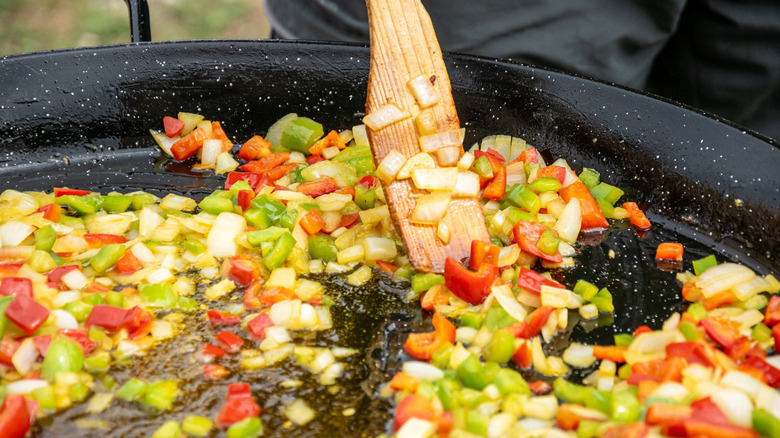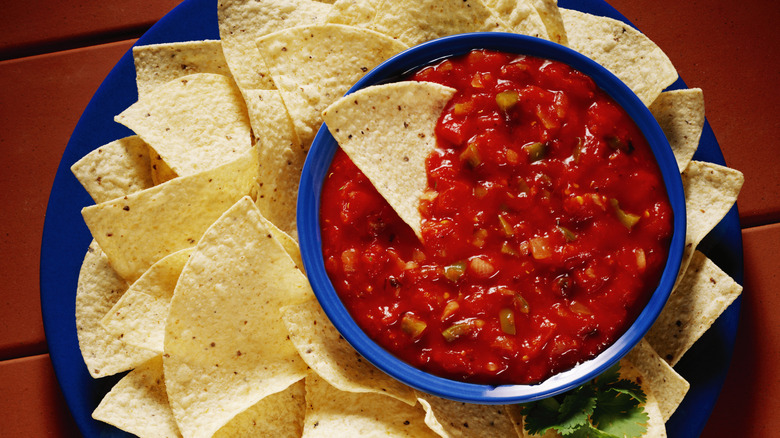Are Sofrito And Salsa The Same Thing?
Some people confuse sofrito and salsa, but they are not, in fact, the same thing, especially within the context of Latin American cuisine. Don't get tripped up because you see they have tomatoes, onions, garlic, and peppers in common. At the end of the day, though, their purpose and use in cooking set them apart.
Sofrito is a versatile flavor base used at the beginning of cooking. You'd usually sautée it in oil and add it to soups, stews, beans, rice, and other dishes to infuse them with rich, aromatic flavor. Depending on the country, sofrito recipes might include additional ingredients like cilantro, culantro, or annatto as part of their unique regional twists. It's not meant to be eaten on its own but rather to enhance the overall depth of a dish.
Salsa is different because it's not a flavor base to build your dish around. It's a condiment served at the end of cooking or alongside a meal. You can have it fresh or cooked with a chunkier or thinner texture, depending on the type. Salsa adds so much flavor to tacos, chips, grilled meats, and other finished dishes. So when you think of them, look at them like sofrito, which is foundational, and salsa, which is more of a finishing touch.
How sofrito and salsa are made and used
Sofrito starts out with finely chopped or blended vegetables, including onions, garlic, and peppers. These ingredients are cooked slowly in oil until you can smell their goodness wafting through the air, often with herbs or spices added to build layers of flavor.
Each country has its own variation; Puerto Rican sofrito features culantro and sweet ají peppers, while Cuban sofrito usually incorporates tomatoes. After preparation, you add sofrito to dishes like rice and beans, stews, or meats, and it serves as the backbone of the meal's flavor.
Salsa, in contrast, is a raw or cooked sauce made to complement finished dishes. Mexican salsa roja (red salsa) uses tomatoes, all different kinds of chilies, and garlic, and you blend it until it's smooth. You also have the close cousin of salsa, pico de gallo, which is a chunky, uncooked mix of fresh ingredients.
Salsa verde, made with tomatillos, is another popular variation. Unlike sofrito, salsa is rarely ever cooked into the dish. You serve it on top or on the side to add brightness, heat, or tanginess. Sofrito and salsa share similar building blocks, but their roles in Latin American cuisine couldn't be more different. Both are essential but in their own distinct ways.
Can you substitute sofrito for salsa (and vice versa)?
Sofrito and salsa are not interchangeable in most recipes due to their different purposes in cooking. If you're stuck and you can't get to the grocery store but you're looking for a salsa-like sauce, you can use sofrito as a mild salsa substitute if it's fresh and uncooked.
For example, freshly blended sofrito with ingredients like tomatoes, peppers, garlic, and herbs can work as a topping for chips or tacos. However, the lack of acidity or heat that's common in salsas won't be there, and as a result, you might feel like it's lacking. Adding lime juice or chilies to the sofrito can help balance it out when used this way.
Salsa doesn't make a great substitute for sofrito. The bold, raw flavors won't achieve the same depth when sautéed. Additionally, the acidity in salsa can overpower dishes that rely on sofrito's subtle, savory base. Ultimately, you can swap them for one another, but should you? Not so much. The sofrito can kind of work, but not the other way around.


